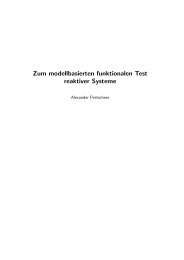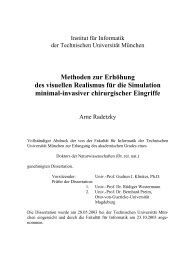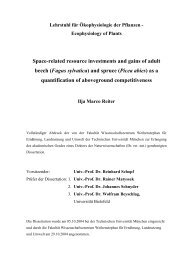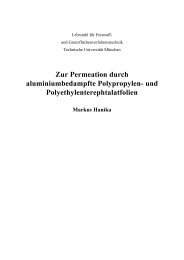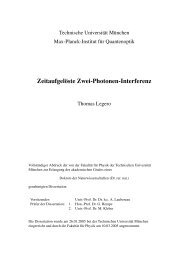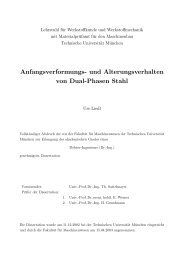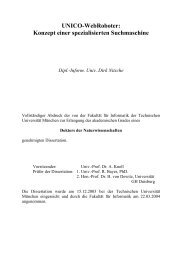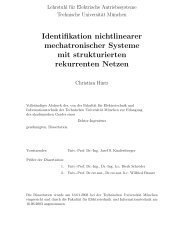Controlling the motion of an atom in an optical cavity
Controlling the motion of an atom in an optical cavity
Controlling the motion of an atom in an optical cavity
Create successful ePaper yourself
Turn your PDF publications into a flip-book with our unique Google optimized e-Paper software.
14 2.2. Classical calculation<br />
<strong>atom</strong>s. Also, because <strong>the</strong> mirrors have a large reflect<strong>an</strong>ce, <strong>the</strong> field distribution <strong>of</strong> <strong>the</strong><br />
near-reson<strong>an</strong>t mode will <strong>in</strong> a very good approximation be given by <strong>the</strong> mode supported<br />
by a <strong>cavity</strong> which is made <strong>of</strong> perfectly reflect<strong>in</strong>g mirrors with <strong>the</strong> same geometry. Under<br />
<strong>the</strong>se circumst<strong>an</strong>ces, <strong>the</strong> electric field distribution <strong>in</strong>side <strong>the</strong> <strong>cavity</strong> which polarizes <strong>the</strong><br />
<strong>atom</strong>s c<strong>an</strong> be approximated by <strong>the</strong> mode <strong>of</strong> a <strong>cavity</strong> made <strong>of</strong> perfectly reflective mirrors.<br />
As a last assumption, <strong>the</strong> frequency <strong>of</strong> <strong>the</strong> light field should be far larger th<strong>an</strong> <strong>the</strong> round<br />
trip frequency <strong>of</strong> <strong>the</strong> light <strong>in</strong>side <strong>the</strong> mode, which <strong>in</strong> turn should be much larger th<strong>an</strong> <strong>the</strong><br />
frequencies attributed to o<strong>the</strong>r mech<strong>an</strong>isms <strong>in</strong>fluenc<strong>in</strong>g <strong>the</strong> light field, e.g. <strong>the</strong> <strong>motion</strong> <strong>of</strong><br />
<strong>the</strong> <strong>atom</strong>s or <strong>the</strong> decay rate <strong>of</strong> <strong>the</strong> <strong>atom</strong>ic dipole moment. Then,<br />
E (r,t)=A (t) e −iωlt ψ (r)+Escat (r,t) , (2.12)<br />
where ψ (r) is <strong>the</strong> mode out <strong>of</strong> <strong>the</strong> ψn (r) <strong>in</strong> Eq. (2.7) which is close to reson<strong>an</strong>ce, <strong>an</strong>d<br />
Escat (r,t) is <strong>the</strong> part <strong>of</strong> <strong>the</strong> electric field scattered by <strong>the</strong> <strong>atom</strong>s which is orthogonal to<br />
<strong>the</strong>mode. TheamplitudeA (t) is under <strong>the</strong> above assumptions slowly vary<strong>in</strong>g <strong>in</strong> time,<br />
i.e. <br />
d2A (t)<br />
dt2 <br />
<br />
dA<br />
(t) <br />
<br />
≪ ωl<br />
<br />
dt ≪ ω2 l |A (t)|. (2.13)<br />
As <strong>the</strong> polarization <strong>of</strong> <strong>the</strong> <strong>atom</strong>s is also <strong>in</strong>duced by <strong>the</strong> light field, it c<strong>an</strong> be written as<br />
P (r,t)=P0 (r,t) e −iωlt<br />
(2.14)<br />
with <br />
d2P0 (r,t)<br />
dt2 <br />
<br />
dP0<br />
(r,t) <br />
<br />
≪ ωl<br />
<br />
dt ≪ ω2 l |P0 (r,t)|. (2.15)<br />
Us<strong>in</strong>g this, time derivatives <strong>of</strong> P0 (r,t) <strong>an</strong>d <strong>the</strong> second time derivative <strong>of</strong> A (t) c<strong>an</strong>be<br />
neglected, <strong>an</strong>d Eq. (2.11) c<strong>an</strong> be recast as<br />
dA (t)<br />
= i<br />
dt<br />
ω2 l − ω2 c<br />
A (t)+i<br />
2ωl<br />
ωl<br />
<br />
d<br />
2ɛ0V<br />
3 rψ ∗ (r) P0 (r,t)<br />
= i∆c A (t)+i ωl<br />
<br />
d<br />
2ɛ0V<br />
3 rψ ∗ (r) P0 (r,t) , (2.16)<br />
where ∆c = ωl − ωc is <strong>the</strong> detun<strong>in</strong>g <strong>of</strong> <strong>the</strong> laser from <strong>the</strong> <strong>cavity</strong> reson<strong>an</strong>ce, <strong>an</strong>d ∆c ≪ ωl<br />
was used to get to <strong>the</strong> second equation.<br />
Now, <strong>the</strong> polarization, P0, is left to be calculated. As was expla<strong>in</strong>ed above, P0 is<br />
<strong>in</strong>duced by <strong>the</strong> electric field E (r,t), which c<strong>an</strong> be approximated by <strong>the</strong> electric field <strong>in</strong><br />
<strong>the</strong> mode, E (r,t) − Escat (r,t), at <strong>the</strong> position <strong>of</strong> <strong>the</strong> o<strong>the</strong>r <strong>atom</strong>s. For two-level <strong>atom</strong>s<br />
which are exposed to monochromatic light with <strong>an</strong> <strong>in</strong>tensity well below <strong>the</strong> saturation<br />
<strong>in</strong>tensity at <strong>the</strong> position <strong>of</strong> <strong>the</strong> <strong>atom</strong>s, <strong>the</strong> polarization is given by (MS99, Eq. (5.26))<br />
P0 (r,t)=iA (t) µ2<br />
¯h<br />
1 <br />
δ (r − rj) ψ (rj) . (2.17)<br />
γ − i∆a j<br />
14



